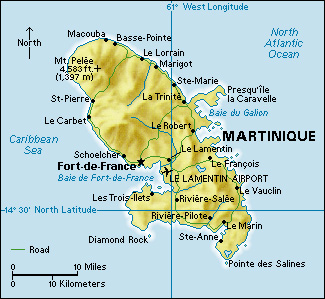Martinique, << `mahr` tuh NEEK, >> is a French island in the Caribbean region. The oval-shaped island covers 421 square miles (1,090 square kilometers). Martinique’s capital is Fort-de-France.

Martinique has many volcanic mountains. The highest and most famous of these is Mount Pelée, which rises 4,583 feet (1,397 meters). This volcano suddenly erupted in 1902 and destroyed the city of St.-Pierre. About 28,000 people died.
Martinique has about 390,000 people. Ninety percent of the people are of African ancestry. Others are of European ancestry, mainly French. Martinique’s sunny climate and beautiful scenery help make tourism its most important industry. Its chief crops are bananas and sugar cane. Lettuce, melons, plantains, and tomatoes also grow there. Other industries include petroleum refining and rum distilling.
The Italian navigator Christopher Columbus reached Martinique in 1502. The French began to colonize the island in 1635. They made Fort-de-France (originally Fort Royal) the capital in 1692.

The French made Martinique an overseas department (administrative district) in 1946. In 1958, Martinique chose to remain a department. It is governed by a general council elected by the people. In 1974, the island also became a region of France. As a region, it has a regional council responsible for social and economic planning. French regions are administrative divisions that roughly resemble states in the United States, and each region has one or more departments. Martinique sends representatives to the French Parliament. In 2009, the people of Martinique voted in a referendum (direct vote by the people) to reject additional self-rule for the island.
See also Fort-de-France ; Mount Pelée .
